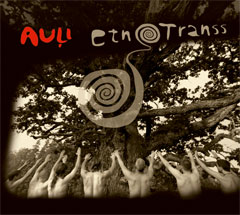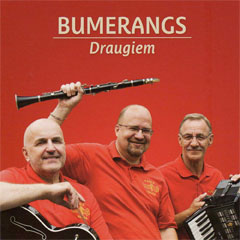
The drum and bagpipe group Auļi has carved out an unusual niche in Latvian folk music. (Publicity photo)

Drum and bagpipe ensemble Auļi occupies a particular niche not just in Latvian music, but in world music in general. Combining drums and bagpipes might not have been the most logical decision, but Auļi has found success and fame for its style and performances.
Making the band’s already eclectic niche even more unusual, Auļi has given a name to its style of music, which is used as the title of its most recent album, 2010’s Etnotranss (or ethno-trance music).
The general idea is that the drums and bagpipes, performing music inspired by Latvian folklore, will mesmerize and put you in a trance-like state, which is what Etnotranss quite effectively accomplishes.
Auļi is made up of bagpipe players Kaspars Bārbals, Leanne Barbo, Gatis Indrēvics, Māris Jēkabsons, Edgars Kārklis and Normunds Vaivads, as well as drummers Mikus Čavarts, Edgars Krūmiņš and Kaspars Indrēvics. The drum and bagpipe sounds are supplemented by Gatis Valters on trough fiddle and special guest Andris Grunte on double bass.
Though Etnotranss is now the group’s third album (after 2005’s Sen dzirdēju and 2007’s Auļos…), the group shows no sign of exhausting the possibilities of this style of music.
The album begins with the aggressive, almost military like “Diņķi,” the introduction to which features the sharp sound of the double bass, foretelling the sonic adventure that lays ahead.
In fact, much of the album is at a fast tempo, with few calm moments along the way. One of the brief moments of calm is the beginning of the song “Karotājs,” but it does not last very long, as the tempo picks up rather dramatically, with an almost Middle Eastern-like melody in the bagpipes.
“Ozols” is a majestic tribute to the mighty oak tree, filled with reverence and awe. My favorite composition is probably “Dieva dēli,” with a particularly catchy melody, and a quite enjoyable bagpipe arrangement, featuring creative interplay between the bagpipes. Also, the song is one of the few “milder” songs on the album, and it strikes me as being a kind of a celebratory dance.
Clearly Auļi is influenced by pagan Latvian traditions and symbolism, judging by the song titles the band has given to the compositions, such as “Dieva dēli,” “Austras koks” and “Krustukrusti.” I get the impression that the group wants to evoke the spirit of ancient Latvia, weaving together mythology and history.
The album booklet features brief essays in Latvian (with English translations) on each song and other topics by author Laima Muktupāvela. The essays are full of pagan Latvian spirituality and philosophy.
Though one might think that the possibilities of just drums and bagpipes might be limited, Auļi once again displays its creativity in the arrangements and performances. With so much of the album being in a fast, almost aggressive tempo, this music is not for the faint of heart! With barely a chance to relax over the course of the album, by the end the listener may very well be truly in a trance-like state, overwhelmed by the intensity of the interplay between the instruments. Etnotranss is truly a remarkable achievement, and the members of Auļi have certainly carved out a rather notable niche for themselves.
Details
Etnotranss
Auļi
Lauska, 2010
87200
Track listing:
Diņķis
Ozols
Dieva dēli
Zemzeme
Karotājs
Krustukrusti
Naidnieks
Dzīvais ūdens
Senā zeme
Tāltālu
Brammanis
Austras koks
Where to buy
Purchase Etnotranss from BalticShop.
Note: Latvians Online receives a commission on purchases.





